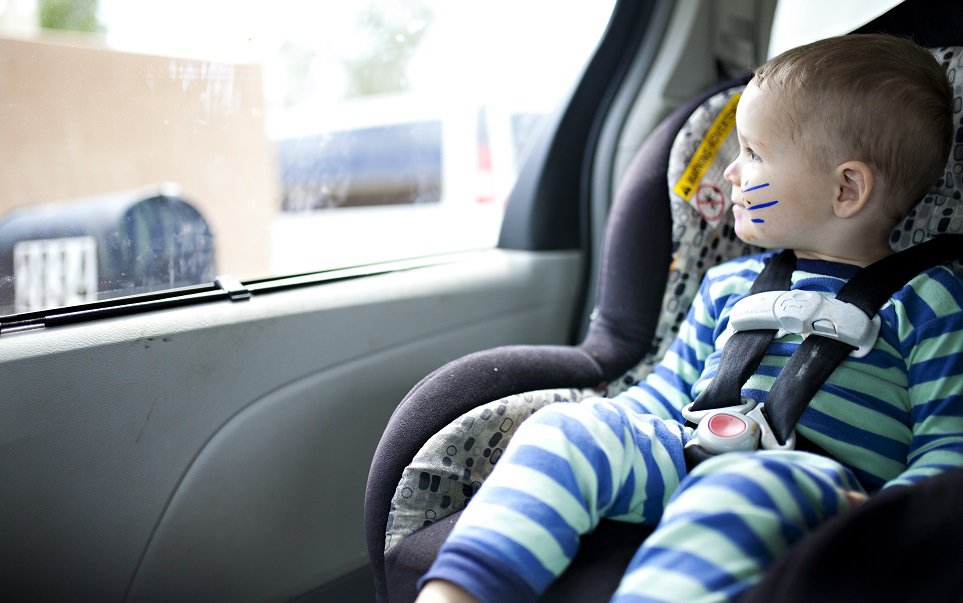- Nuna Rava vs Maxi Cosi Pria 85 – Which Convertible Car Seat Is Best? - January 31, 2023
- Nuna Rava vs Graco 4Ever – Which One is Better? - December 7, 2022
- Chicco KeyFit 35 vs Chicco KeyFit 30 - September 30, 2022
From the excellent education system and a strong economy to the rich historical and cultural heritage, the Buckeye State may be an ideal place to raise a family, but for many a new parent, the strict safety seat laws can be confusing, if not completely overwhelming.
That’s where we come in. Here, you’ll find all of the Ohio car seat laws explained in crystal clear detail. That way, you’ll have all the information you need to help make a fully informed decision about the best car seat for your growing family.
We’ll also discuss when it might be time to change that safety seat for a standard booster seat, and answer all of your most pressing questions about in-car safety when traveling with your young ones.
Table of Contents
Ohio Car Seat Laws Explained in Brief
Since they were first introduced in 2009, Ohio’s car safety seat laws have changed very little, and are actually very straightforward. We’ll cover each rule in more detail below but for now, here are the basics: Infants and children must travel in a child safety seat which meets Federal motor vehicle safety standards until they are four years old and weigh at least 40 lbs.
From the ages of four to eight years old, children no longer using a standard safety seat must use a booster seat until they reach 4’9” tall. From the ages of eight to 15, children not in booster seats must use the standard-fitted adult seat belts.
Rear-Facing Car Seats: What You Need to Know

Front-Facing Car Seats: What You Need to Know
Once a child reaches their first birthday and weighs at least 20 lbs, they can be moved into a forward-facing car seat. Though experts recommend keeping them rear-facing for as long as possible, you might find it more convenient to choose a long-lasting option that can serve as both.
Our recommended Safety 1st Alpha Omega Elite Convertible Car Seat, for example, starts life as a rear-facing infant car seat. As your child grows, the infant support can be removed so that the seat can be used as a forward-facing option until your child turns four, after which it can be converted again into a quality booster seat. Speaking of which…
Backless or High-Back Booster Seats
Once your child turns four, they can progress to a simple booster seat until they either turn eight years old or reach 4’9” in height, whichever comes first. The law doesn’t state whether a backless or high-back option like the popular Graco Highback Turbobooster are required, so you’re free to shop around and find the best option for your young one.
Do Children Need Seat Belts?
Though it goes without saying that everybody in your car should be strapped in for every journey, under Ohio state law, children under the age of 15 must be protected by either a child safety seat or a seat-belt. For smaller children, a special seat belt adjuster like this one from SSAWcasa may be advisable.
The standard seat belts in the back of your car are designed to fit adult bodies, meaning they don’t offer the kind of full protection your growing child needs. An ill-placed seat belt strap can cause major damage to the abdomen, chest, and spinal column.
A booster seat can often make a big difference for children who have outgrown their ‘baby’ seat, but a combination of a booster and seat belt adjuster provides that added level of protection without compromising their comfort.
What are the Penalties for Violating Ohio Child Car Seat Laws?
The Child Passenger Safety laws are not something Ohio lawmakers take lightly. Failing to ensure your child is properly secured in the appropriate child seat is classed as a minor misdemeanor, and comes with a fine of between $25 and $75 for a first offense
If you violate the child seat laws again, that’s then classed as a misdemeanor of the fourth degree. This carries a fine of up to $250 plus court costs, with the possibility of 30 days’ jail time. While it’s true that a prison sentence may be unlikely, it is a real option and not one that any parent should want to risk.
On the positive side, any fines collected go to the Ohio Child Highway Safety Fund to further promote greater levels of safety for the state’s children.
What are the Exceptions to the Ohio Child Passenger Safety Laws?

According to The State of Ohio Laws on Child Restraints and Seat Belts, there are two notable exceptions to the rules.
The Emergency Exception
The actual law states that a child seat is not necessary “when an emergency exists that threatens the life of any person operating or occupying a motor vehicle that is being used to transport a child who otherwise would be required to be restrained.”
In other words, let’s say your partner has a major accident and needs to be rushed to the emergency room. You have your baby with you, but the only car available doesn’t have a child seat. In that case, the emergency situation takes precedent. There’s no reason to rush out and buy a car seat before you can get your beloved to the hospital.
The Physical Impairment Exception
The other major exception is if a car seat would actually do your child more harm than good during day-to-day use. After all, you could have the best travel car seat on the market, but if it’s going to be of little help if your child’s special physical needs make it impossible or impractical for use.
If you do think this applies to you, then there are two important things that you need to keep in mind:
1: You’ll need to get an affidavit signed by either a physician or chiropractor licensed by the state of Ohio
2: You’ll need to follow any advice or recommendations from that physician or chiropractor about the best way to keep your child safe.
Special KARS (Special Kids Are Riding Safe) Program
If you’re living in Northern Ohio, then you might want to know about Special KARS (Special Kids Are Riding Safe), a unique program backed by the Academy of Pediatrics which offers practical help and guidance to parents whose children can’t use a standard car seat because of size, disability, or injury.
Normally use a reputable brand like the Evenflo SureRide DLX but find it’s no longer suitable after your young one gets into an unfortunate accident that requires a leg cast? The program may be able to help you out with a six-month loan of specially-fitted child restraints.
The program also offers consultation and education for parents on how to ensure children are safe and comfortable while traveling, no matter what their needs may be. KARS can be contacted at 1.888.710.3020 or by email [email protected].
I’m in Ohio and Can’t Afford a Car Seat. What Should I Do?

A good quality car seat doesn’t have to cost a fortune. For children who only require a simple booster seat, for example, Cosco’s Topside Backless Booster Car Seat is a solid, no-frills option in the $15 – $30 range.
Still, let’s face it: For big families with growing children, those car seat costs can take a big bite out of your finances, especially if they’re already stretched to their limit. The good news is that you may be able to get support from the Ohio Buckles Buckeyes initiative which offers free child safety and booster seats to low-income families throughout Ohio.
How to Qualify for Ohio Buckles Buckeyes
To be eligible for support, your family’s income must be within the threshold set by the Women, Infants, and Children (WIC) program, though you don’t necessarily need to receive state benefits to qualify.
Before picking up your seat, you’ll be required to attend a short class where you’ll learn how to install and use it.
FAQs
Answer: Before the laws were introduced, Ohio had one of the highest rates of child deaths and injuries due to road accidents. From 1999 to 2006, 34 children aged four to seven years passed away as a result of being in a car accident. Yet only 18% of parents in the state were using child safety seats, one of the lowest percentages in the country.
The state of Ohio knew that 34 children was 34 too many, and set about making positive changes by making child safety seats and booster seats mandatory. Sadly, in the United States as a whole, road accidents continue to be a leading cause of deaths and serious injuries among children.
In 2017 alone, 675 US children under 12 died as a result of being in a car accident while almost 116,000 were injured. Of those who passed away, 35% were not adequately restrained. Though these figures themselves ensure that adequate safety seating remains as important as ever, the introduction of new laws has ensured that Ohio contributes far less to those statistics than it once did.
Answer: Simply put, the standard seatbelts in your car just aren’t designed for children and don’t sit across the right parts of their bodies to keep them safe. Without a booster seat, the part of the seat belt that is supposed to sit across the upper thighs could press into their abdomen, causing injuries to that area, as well as to the spinal column, in the case of an accident.
Meanwhile, the use of a car seat has been shown to significantly reduce the risk of injury by as much as 82% when compared to seat belt use alone, with booster seat usage reducing injuries to children aged 4-8 by 45% compared to only using a seat belt.
Answer: Children must be at least 13 years old before they’re allowed to ride in the front passenger seat with you and must be wearing a seat belt at all times. Even though Ohio law has no height requirement for children sitting in the front seat, those who do usually state that children should be at least 4’9″ before they’re allowed to ride upfront.
That said, children are always safer when riding in the back seat with a seat belt on. So, although we all get the allure of the magical front seat for kids, insisting they sit in the back for as long as possible is always advised.
Answer: Although there’s no regulation in place to say you can’t re-use a car seat, both child safety experts and seat manufacturers alike recommend using the same car seat for no more than six to ten years. While it’s easy to dismiss this as a ploy to sell more seats, there’s actually some sound logic to it.
Although they’re built to be highly durable, car seats are not impervious to wear and tear. Sure, the odd scuff here and there may not seem as though it would make a huge difference, multiple scuffs, scrapes, and tears soon add up, leaving a chair that is no longer capable of providing the kind of protection it once did.
That’s to say nothing of the energy-absorbing foam inside the chair which will eventually degrade after years of use. There’s also the small matter of your child’s size. The expensive infant safety seat you bought three years ago may have been perfect for your eldest, but if their younger sibling is much smaller, it may not provide the same level of protection.
All told then, though you may be able to get away with reusing the same car seat for siblings of a similar size who were born close together, they’ll always benefit from having a new seat, especially for them. On a related note, this is the exact same reason why experts always recommend buying a brand new car seat rather than a second-hand model.
Final Thoughts
Though a child car seat may not be the most exciting of purchases, that doesn’t mean it’s one you can take lightly, picking up the first one you see on the shelf at Walmart and calling it a day. To ensure maximum safety and comfort for your little one, it pays to do the research and carefully select a model that’s not only perfect for their current size, but that will also remain comfortable for them as they get older.
While doing this research, be sure to check whether the car seat you’re considering meets Federal Motor Vehicle Safety Standard 213. You can usually determine this by a label attached to the seat itself, though if you’re in doubt, you can always contact the manufacturer.
Recommended Reads:
- The Best Infant Car Seats for Small Cars That You’ll Love
- How Long Are Car Seats Good For & How to Dispose Them?
- The Best Travel Car Seats for 2019 That Every Parent Need
- Arkansas Car Seat Laws Explained: All You Need to Know
- Illinois Car Seat Laws Explained: All You Need to Know
- Nebraska Car Seat Laws Explained
- Wyoming Car Seat Laws Explained
- Missouri Car Seat Laws Guide
- Kansas Car Seat Laws Guide
- California Car Seat Laws Guide
- Texas Car Seat Laws Guide



